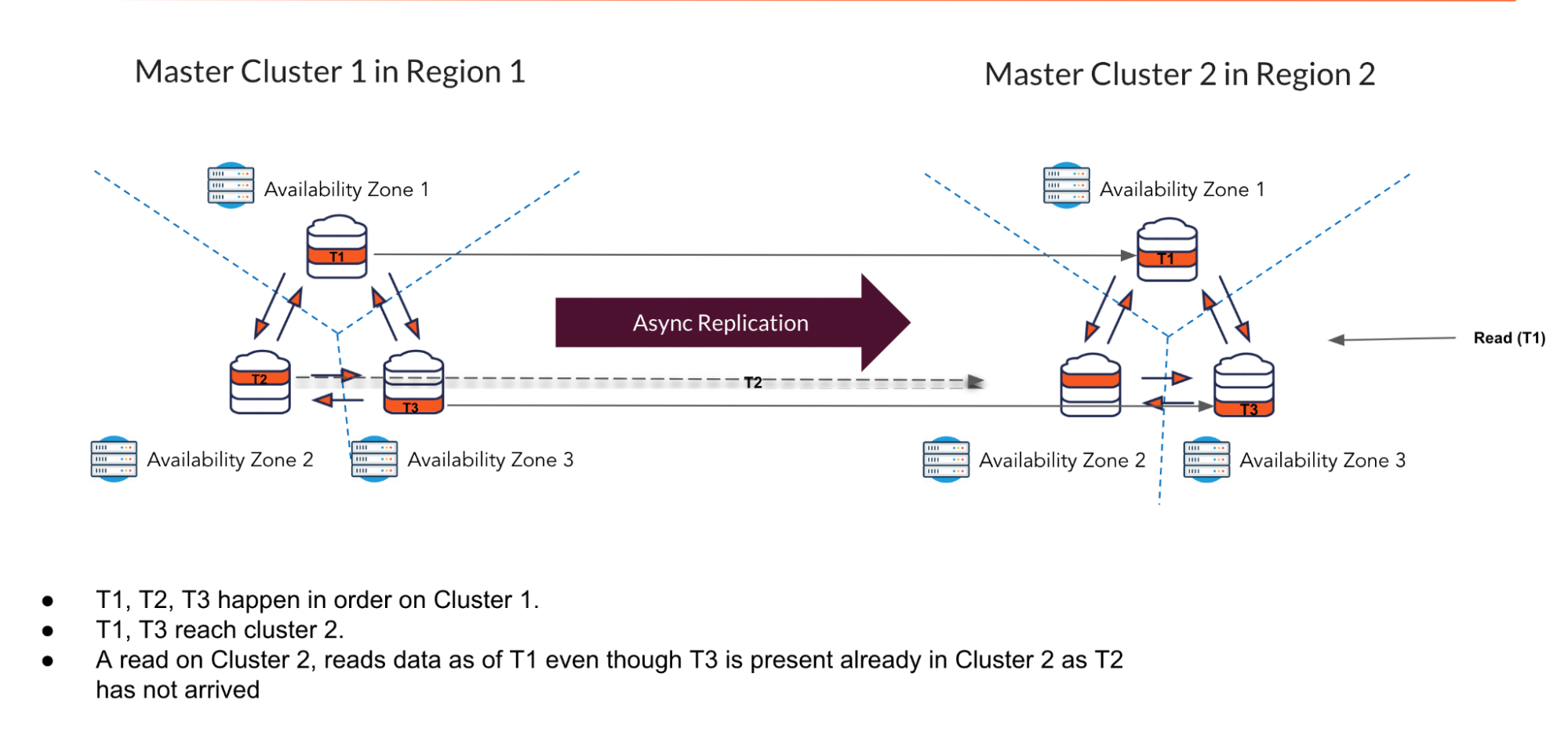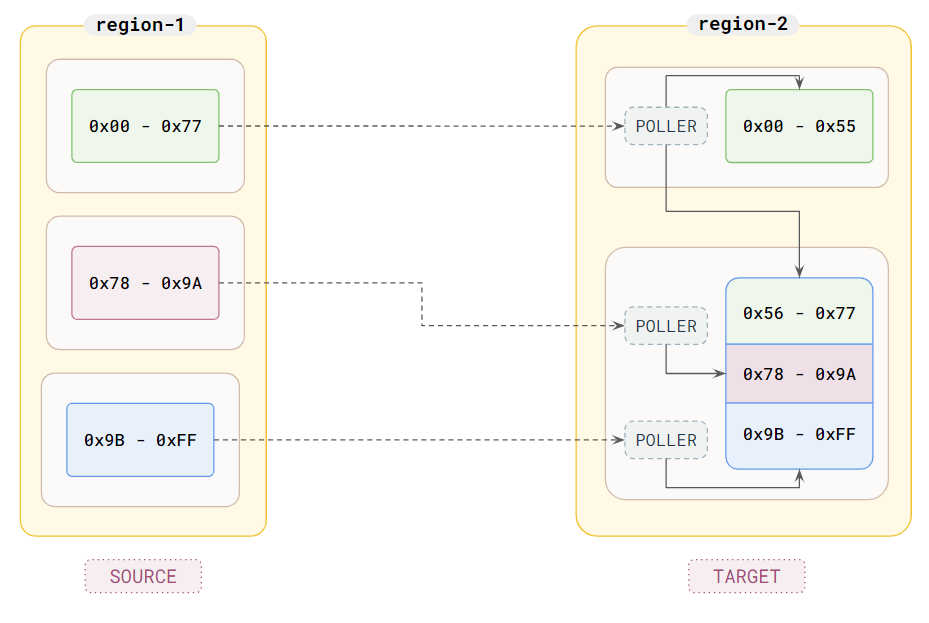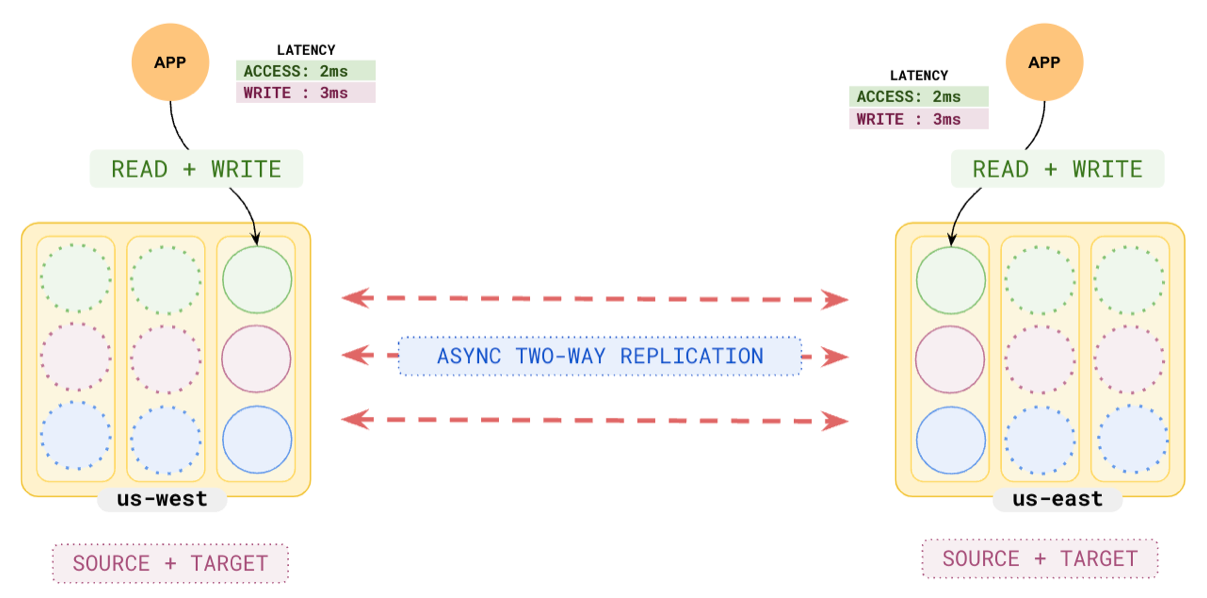xCluster replication

YugabyteDB's xCluster replication
xCluster replication is YugabyteDB's implementation of high throughput asynchronous physical replication between two YugabyteDB universes. It allows you to set up one or more unidirectional replication flows between universes. For each flow, data is replicated from a source (also called a producer) universe to a target (also called a consumer) universe. Replication is done at the DocDB layer, by efficiently replicating WAL records asynchronously to the target universe. Both YSQL and YCQL are supported.
Multiple flows can be configured; for instance, setting up two unidirectional flows between two universes, one in each direction, enables bidirectional replication. This ensures that data written in one universe is replicated to the other without causing infinite loops. Refer to supported deployment scenarios for details on the supported flow combinations.
For simplicity, flows are described as being between entire universes. However, flows are actually composed of streams between pairs of YCQL tables or YSQL databases, one in each universe, allowing replication of only certain tables or databases.
Note that xCluster can only be used to replicate between primary clusters in two different universes; it cannot be used to replicate between clusters in the same universe. (See universe versus cluster for more on the distinction between universes and clusters.)
Synchronous versus asynchronous replication
YugabyteDB's synchronous replication can be used to tolerate losing entire data centers or regions. It replicates data in a single universe spread across multiple (three or more) data centers so that the loss of one data center does not impact availability, durability, or strong consistency enabled by the Raft consensus algorithm.
However, asynchronous replication can be beneficial in certain scenarios:
- Low write latency: With synchronous replication, each write must reach a consensus across a majority of data centers. This can add tens or even hundreds of milliseconds of extra latency for writes in a multi-region deployment. xCluster reduces this latency by eliminating the need for immediate consensus across regions.
- Only two data centers needed: With synchronous replication, to tolerate the failure of
ffault domains, you need at least2f + 1fault domains. Therefore, to survive the loss of one data center, a minimum of three data centers is required, which can increase operational costs. For more details, see fault tolerance. With xCluster, you can achieve multi-region deployments with only two data centers. - Disaster recovery: xCluster utilizes independent YugabyteDB universes in each region that can function independently of each other. This setup allows for quick failover with minimal data loss in the event of a regional outage caused by hardware or software issues.
Asynchronous xCluster replication has the following drawbacks:
- Potential data loss: In the event of a data center failure, any data that has not yet been replicated to the secondary data center will be lost. The extent of data loss is determined by the replication lag, which is typically subsecond but can vary depending on the network conditions between the data centers.
- Stale reads: When reading from the secondary data center, there may be a delay in data availability due to the asynchronous nature of the replication. This can result in stale reads, which may not reflect the most recent writes. Non-transactional modes can serve torn reads of recently written data.
Asynchronous replication modes
Because there is a useful trade-off between how much consistency is lost and what transactions are allowed, YugabyteDB provides two different modes of asynchronous replication:
- Non-transactional replication: Writes are allowed on the target universe, but reads of recently replicated data can be inconsistent.
- Transactional replication: Consistency of reads is preserved on the target universe, but writes are not allowed.
Non-transactional replication
All writes to the source universe are independently replicated to the target universe, where they are applied with the same timestamp they committed on the source universe. No locks are taken or honored on the target side.
Due to replication lag, a read performed in the target universe immediately after a write in the source universe may not reflect the recent write. In other words, reads in the target universe do not wait for the latest data from the source universe to become available.
Note that the writes are usually being written in the past as far as the target universe is concerned. This violates the preconditions for YugabyteDB serving consistent reads (see the discussion on safe timestamps). Accordingly, reads on the target universe are no longer strongly consistent but rather eventually consistent even in a single table.
If both target and source universes write to the same key, then the last writer wins. The deciding factor is the underlying hybrid time of the updates from each universe.
Inconsistencies affecting transactions
Due to the independent replication of writes, transactions from the source universe become visible over time. This results in transactions on the target universe experiencing non-repeatable reads and phantom reads, regardless of their declared isolation level. Consequently, all transactions on the target universe effectively operate at the SQL-92 isolation level READ COMMITTED, which only ensures that transactions do not read uncommitted data. Unlike the standard YugabyteDB READ COMMITTED level, this does not guarantee that a statement will see a consistent snapshot or all data committed before the statement is issued.
If the source universe fails, the target universe may be left in an inconsistent state where some source universe transactions have only some of their writes applied in the target universe (these are called torn transactions). This inconsistency will not automatically heal over time and may need to be manually resolved.
Note that these inconsistencies are limited to the tables/rows being written to and replicated from the source universe: any target transaction that does not interact with such rows is unaffected.
Transactional replication
In this mode, reads occur at a time sufficiently in the past (typically 1-2 seconds) to ensure that all relevant data from the source universe has already been replicated. Additionally, writes to the target universe are not allowed.
Reads occur as of the xCluster safe time, ensuring that all writes from all source transactions that will commit at or before the xCluster safe time have been replicated to the target universe. This means we read as of a time far enough in the past that there cannot be new incoming commits at or before that time. This guarantees consistent reads and ensures source universe transactions become visible atomically. Note that the xCluster safe time is not blocked by any in-flight or long-running source-universe transactions.
xCluster safe time advances as replication proceeds but lags behind real-time by the current replication lag. This means, for example, if we write at 2:00:00 PM in the source universe and read at 2:00:01 PM in the target universe and replication lag is, say, five seconds, then the read may read as of 1:59:56 PM and will not see the write. We may not be able to see the write until 2:00:06 PM in the target universe, assuming the replication lag remains at five seconds.

If the source universe fails, we can discard all incomplete information in the target universe by rewinding it to the latest xCluster safe time (1:59:56 PM in the example) using YugabyteDB's Point-in-Time Recovery (PITR) feature. The result will be a consistent database that includes only the transactions from the source universe that committed at or before the xCluster safe time. Unlike with non-transactional replication, there is no need to handle torn transactions.
Target universe read-only transactions run at serializable isolation level on a single consistent snapshot as of the xCluster safe time.
In xCluster transactional replication mode, writes to the target universe are not allowed. Consequently, this mode does not support bidirectional replication.
Transactional replication is currently only available for YSQL deployments.
Transactional replication comes in three modes:
Automatic mode
TP In this mode all aspects of replication are handled automatically, including schema changes.
Semi-automatic mode
Provides operationally simpler setup and management of replication, as well as fewer steps for performing DDL changes. This is the recommended mode for new deployments.
Manual mode
This mode is deprecated and not recommended for new deployments. It requires manual intervention for schema changes and is more complex to set up and manage.
High-level implementation details
xCluster replicates WAL records from source universe tablets to target universe tablets. It is implemented by having pollers in the target universe that poll the source universe tablet servers for WAL records. Each poller works independently and polls one source tablet, distributing the received changes among one or more target tablets. This allows xCluster to scale horizontally as more nodes are added.
The polled tablets examine only the WAL to determine recent changes rather than looking at their RocksDB instances. The incoming poll request specifies the WAL OpId to start gathering changes from, and the response includes a batch of changes and the WAL OpId to continue with next time.
The source universe periodically saves the OpId that the target universe has confirmed as processed. This information is stored in the cdc_state table.
The mapping between source and target tablets
In simple cases, each target tablet can have a dedicated poller that directly polls the corresponding source tablet. However, in more complex scenarios, the number of tablets in the source and target universes may differ. Even if the number of tablets is the same, their sharding boundaries might not align due to historical tablet splits occurring at different points in time.
This means that each target tablet may require changes from multiple source tablets, and multiple target tablets may need changes from the same source tablet. To prevent redundant cross-universe reads from the same source tablet, only one poller reads from each source tablet. When a source tablet's changes are needed by multiple target tablets, the assigned poller distributes the changes to the relevant target tablets.
The following illustration shows an example of this setup for a single table:

In the illustration, the source universe is depicted on the left with three TServers (white boxes), each containing one tablet of the table (boxes inside) with specified ranges. The target universe is on the right, featuring one fewer TServer and tablet. The data from the top source tablet is distributed among both target tablets by the poller in the top target TServer. Meanwhile, the data from the remaining source tablets is replicated to the second target tablet by the pollers in the other target TServer. For simplicity, only the tablet leaders are shown, as pollers operate at and poll from leaders only.
Tablet splitting generates WAL records, which are replicated to the target side. This ensures that the mapping of pollers to source tablets is automatically updated as needed when a source tablet splits.
Single-shard transactions
When a single-shard transaction commits, a single WAL record is generated that includes all the writes and the commit time for that transaction. This WAL record is then included in a batch of changes when the poller requests updates. Single-shard transactions only modify a single tablet.
Upon receiving the changes, the poller examines each write to determine the key it writes to and identifies the corresponding target tablet. The poller then forwards the writes to the appropriate tablets. The commit times of the writes are preserved, and the writes are marked as external. This marking prevents them from being further replicated by xCluster, whether onward to another cluster or back to the original cluster in bidirectional replication scenarios.
Distributed transactions
Distributed transactions involve multiple WAL records and the transaction status tablet. Writes generate provisional records (intents) and corresponding WAL records linked to a transaction on the involved user tablets. The state of the transaction is tracked by one transaction status tablet. The transaction is committed by updating the transaction state in the transaction status tablet, which produces a WAL record. After the commit is made durable, all involved tablets are asynchronously informed to apply the transaction. This process converts provisional writes into regular writes and generates a further WAL record. The provisional records are made available for reads immediately after the commit, even if the apply has not occurred yet.
On the target universe, xCluster generates a special inert format for provisional records. This format omits the original row locking information and an additional index on the key in the intents DB, as these are unnecessary on the target side.
When a poller receives an apply WAL record, it distributes it to all the target tablets it manages. The transaction application on the target tablets mirrors that of the source universe. It converts the provisional writes into regular writes, maintaining the same commit time as on the source universe and marking them as external. At this stage, the transaction's writes to this tablet become visible for reads.
Because pollers operate independently and the writes to multiple tablets are not applied atomically, writes from a single transaction affecting multiple tablets can become visible at different times.
When a source transaction commits, it is applied to the relevant tablets lazily. This means that even though transaction X commits before transaction Y, X's apply WAL record may occur after Y's apply WAL record on some tablets. If this happens, the writes from X can become visible in the target universe after Y's. This is why non-transactional mode reads are only eventually consistent and not timeline consistent.
Transactional mode
Transactional mode addresses these issues by selecting an appropriate xCluster safe time.
The xCluster safe time for each database on the target universe is calculated as the minimum xCluster apply safe time reached by any tablet in that database. Pollers use information from the source tablet leaders to determine their xCluster apply safe time. This time ensures that all transactions committed before it have been applied on the target tablets.
A source tablet leader determines the xCluster apply safe time that the target poller can advance to based on the state of the apply operations of committed transactions. It periodically (every 250 ms) checks the state of in-flight transactions and generates apply WAL records for committed transactions. This ensures that the xCluster apply safe time can keep advancing even when there are long-running transactions in the system.
Schema differences
xCluster replication requires that the source and target tables have identical schemas. This means that you cannot replicate data between tables if there are differences in their schemas, such as missing columns or columns with different data types. Ensuring schema consistency is crucial for the replication process to function correctly.
Additionally, this restriction includes hidden schema metadata, such as the assignment of column IDs. Even if two tables appear to have the same schema in YSQL, their schemas might not be identical. Therefore, in practice, the target table schema should be copied from the source table schema. For more details, refer to replication bootstrapping.
Because of this restriction, xCluster does not need to perform deep translations of row contents (such as dropping columns or translating column IDs within keys and values) when replicating rows between universes. This avoidance of deep translation reduces the replication cost and improves throughput.
Schema changes must be manually applied first to the source universe and then to the target universe. During this process, replication for the affected table is automatically paused when schema differences are detected and resumes once the schemas are identical.
Replication bootstrapping
xCluster replicates the source WAL records to the target universe. WAL is garbage collected over time to conserve disk space. When setting up a new replication flow, the source universe may have already deleted some of the WAL records needed for an empty target universe to catch up. This is especially likely if the source universe has been running for a while and has accumulated a lot of WAL.
In this case, you need to bootstrap the target universe.
This process involves checkpointing the source universe to ensure that any new WAL records are preserved for xCluster. Following this, a distributed backup is performed and restored to the target universe. This not only copies all the data but also ensures that the table schemas are identical on both sides.
Deployment scenarios
xCluster currently supports active-active single-master and active-active multi-master deployments.
Active-active single-master
In this setup, replication is unidirectional from a source universe to a target universe, typically located in different data centers or regions. The source universe can handle both reads and writes, while the target universe is read-only. Since only the source universe can accept writes, this mode is referred to as single-master. Note that within the source universe, all nodes can serve writes.
These deployments are typically used for serving low-latency reads from the target universes and for disaster recovery purposes. When the primary purpose is disaster recovery, these deployments are referred to as active-standby, as the target universe is on standby to take over if the source universe fails.
Transactional mode is generally preferred here because it ensures consistency even if the source universe is lost. However, non-transactional mode can also be used depending on the specific requirements and trade-offs.
The following diagram shows an example of this deployment:

Active-active multi-master
In a multi-master deployment, data replication is bidirectional between two universes, allowing both universes to perform reads and writes. Writes to any universe are asynchronously replicated to the other universe with a timestamp for the update. This mode implements last-writer-wins, where if the same key is updated in both universes around the same time, the write with the larger timestamp overrides the other one. This deployment mode is called multi-master because both universes serve writes.
The multi-master deployment utilizes bidirectional replication, which involves two unidirectional replication streams operating in non-transactional mode. Special measures are taken to assign timestamps that ensure last-writer-wins semantics, and data received from the replication stream is not re-replicated.
The following diagram illustrates this deployment:

Unsupported deployment scenarios
The following deployment scenarios are not yet supported:
-
Broadcast: This topology involves one source universe sending data to many target universes, for example:
A -> B, A -> C. See #11535 for details. -
Consolidation: This topology involves many source universes sending data to one central target universe, for example:
B -> A, C -> A. See #11535 for details. -
Daisy chaining: This involves connecting a series of universes, for example:
A -> B -> C -
Star: This involves connecting all universes to each other, for example:
A <-> B <-> C <-> A
Limitations
The following limitations apply to all xCluster modes and deployment scenarios:
-
Materialized views
Materialized views are not replicated by xCluster. When setting up replication for a database, materialized views need to be excluded. You can create them on the target universe after the replication is set up. When refreshing, make sure to refresh on both sides.
-
Backups
Backups are supported on both universes. However, for backups on target clusters, if there is an active workload, the consistency of the latest data is not guaranteed. This applies even to transactional modes. Therefore, it is recommended to take backups on the source universe only.
-
Change Data Capture
CDC gRPC protocol and PostgreSQL protocol are not supported on the target universe. It is recommended to set up CDC on the source universe only.
-
Modifications of Types
When xCluster is active, composite user types, array types whose base types are row types, domains, and other non-primitive types should not be created, altered, or dropped. Create these types before xCluster is set up. If you need to modify these types, you must first drop xCluster replication, make the necessary changes, and then re-enable xCluster via bootstrap. #24078, #24079
Limitations specific to each scenario and mode are listed below:
Non-transactional
-
Consistency issues
Refer to Inconsistencies affecting transactions for details on how non-transactional mode can lead to inconsistencies.
-
Enum types
When xCluster is active, user-defined ENUM types should not be created, altered, or dropped. Create these types before xCluster is set up. If you need to modify these types, you must first drop xCluster replication, make the necessary changes, and then re-enable xCluster via bootstrap.
Multi-master asynchronous replication
-
Triggers
Because xCluster replication operates at the DocDB layer, it bypasses the query layer. So, only the database triggers on the source universe are fired, and the ones on the target side are not fired. It is recommended to avoid using the same triggers on both universes to avoid any confusion.
-
Indexes and Constraints
In active-active multi-master setups, unique constraints cannot be guaranteed. When conflicting writes to the same key occur from separate universes simultaneously, they can violate unique constraints or result in inconsistent indexes. For example, two conflicting writes might result in both rows being present in the main table, but only one row in the index.
Note that if you attempt to insert the same row on both universes at the same time to a table that does not have a primary key, you will end up with two rows with the same data. This is the expected PostgreSQL behavior — tables without primary keys can have multiple rows with the same data.
-
Sequences and Serial columns
Sequence data is not replicated by xCluster. Serial columns use sequences internally. Avoid serial columns in primary keys, as both universes would generate the same sequence numbers, resulting in conflicting rows. It is recommended to use UUIDs instead.
Transactional
- No writes are allowed in the target universe.
- YCQL is not yet supported.
- In Semi-automatic and Manual modes, schema changes are not automatically replicated. They must be manually applied to both source and target universes. Refer to DDLs in semi-automatic mode and DDLs in manual mode for more information.
Transactional Automatic mode
- All connections to the source universe must be reset after setting up the replication. #25853
- The GRANT statement is currently not replicated. #26461
- Adding unique constraints is currently not supported. #26167
- Table rewrites (ALTER TABLE commands that require structural changes to the table) on partitioned tables are currently not supported. #26453
- Global objects like Users, Roles, and Tablespaces are not replicated. These objects must be manually created on the standby universe.
- DDLs related to Materialized Views (CREATE, DROP, and REFRESH) are not replicated. You can manually run these on both universes by setting the YSQL configuration parameter
yb_xcluster_ddl_replication.enable_manual_ddl_replicationtotrue. - CREATE TABLE AS and SELECT INTO DDL statements are not supported. You can work around this by breaking the DDL into a CREATE TABLE followed by INSERT SELECT.
- ALTER COLUMN TYPE, ADD COLUMN ... SERIAL, TRUNCATE, and ALTER LARGE OBJECT DDLs are not supported.
- DDLs related to PUBLICATION and SUBSCRIPTION are not supported.
- While Automatic mode is active, you can only CREATE, DROP, or ALTER the following extensions: file_fdw, fuzzystrmatch, pgcrypto, postgres_fdw, sslinfo, uuid-ossp, hypopg, pg_stat_monitor, and pgaudit. All other extensions must be created before setting up automatic mode.
Transactional Semi-Automatic and Manual mode
- All DDL changes must be manually applied to both source and target universes. For more information, refer to DDLs in semi-automatic mode and DDLs in manual mode.
- When xCluster is active, user-defined ENUM types should not be created, altered, or dropped. Consider setting up these types before xCluster is set up. If you need to modify these types, you must first drop xCluster replication, make the necessary changes, and then re-enable xCluster via bootstrap.
Kubernetes
- xCluster replication can be set up with Kubernetes-deployed universes. However, the source and target must be able to communicate by directly referencing the pods in the other universe. In practice, this either means that the two universes must be part of the same Kubernetes cluster or that two Kubernetes clusters must have DNS and routing properly set up amongst themselves.
- Having two YugabyteDB universes, each in their own standalone Kubernetes cluster, communicating with each other via a load balancer, is not currently supported. See #2422 for details.